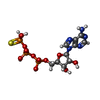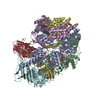+ データを開く
データを開く
- 基本情報
基本情報
| 登録情報 | データベース: PDB / ID: 8ui7 | ||||||||||||
|---|---|---|---|---|---|---|---|---|---|---|---|---|---|
| タイトル | Cryo-EM map of human clmap-clamp loader ATAD5-RFC-gapped PCNA complex in intermediate state 3 | ||||||||||||
 要素 要素 |
| ||||||||||||
 キーワード キーワード | MOTOR PROTEIN / AAA ATPase / Clamp unloader | ||||||||||||
| 機能・相同性 |  機能・相同性情報 機能・相同性情報DNA clamp unloader activity / positive regulation of cell cycle G2/M phase transition / Elg1 RFC-like complex / nuclear DNA replication / DNA replication factor C complex / Ctf18 RFC-like complex / positive regulation of deoxyribonuclease activity / dinucleotide insertion or deletion binding / PCNA-p21 complex / mitotic telomere maintenance via semi-conservative replication ...DNA clamp unloader activity / positive regulation of cell cycle G2/M phase transition / Elg1 RFC-like complex / nuclear DNA replication / DNA replication factor C complex / Ctf18 RFC-like complex / positive regulation of deoxyribonuclease activity / dinucleotide insertion or deletion binding / PCNA-p21 complex / mitotic telomere maintenance via semi-conservative replication / positive regulation of isotype switching to IgG isotypes / purine-specific mismatch base pair DNA N-glycosylase activity / DNA clamp loader activity / nuclear lamina / positive regulation of DNA-directed DNA polymerase activity / Polymerase switching / MutLalpha complex binding / Processive synthesis on the lagging strand / Telomere C-strand (Lagging Strand) Synthesis / PCNA complex / Removal of the Flap Intermediate / isotype switching / Mismatch repair (MMR) directed by MSH2:MSH3 (MutSbeta) / Mismatch repair (MMR) directed by MSH2:MSH6 (MutSalpha) / Processive synthesis on the C-strand of the telomere / Transcription of E2F targets under negative control by DREAM complex / Polymerase switching on the C-strand of the telomere / Removal of the Flap Intermediate from the C-strand / replisome / response to L-glutamate / HDR through Single Strand Annealing (SSA) / regulation of mitotic cell cycle phase transition / DNA strand elongation involved in DNA replication / negative regulation of intrinsic apoptotic signaling pathway in response to DNA damage by p53 class mediator / response to dexamethasone / DNA synthesis involved in DNA repair / Impaired BRCA2 binding to RAD51 / histone acetyltransferase binding / DNA polymerase processivity factor activity / G1/S-Specific Transcription / leading strand elongation / nuclear replication fork / replication fork processing / Presynaptic phase of homologous DNA pairing and strand exchange / SUMOylation of DNA replication proteins / signal transduction in response to DNA damage / PCNA-Dependent Long Patch Base Excision Repair / intrinsic apoptotic signaling pathway in response to DNA damage by p53 class mediator / ATP-dependent activity, acting on DNA / response to cadmium ion / translesion synthesis / estrous cycle / mismatch repair / Activation of ATR in response to replication stress / cyclin-dependent protein kinase holoenzyme complex / base-excision repair, gap-filling / DNA polymerase binding / positive regulation of B cell proliferation / liver regeneration / epithelial cell differentiation / positive regulation of DNA repair / TP53 Regulates Transcription of Genes Involved in G2 Cell Cycle Arrest / Translesion synthesis by REV1 / Translesion synthesis by POLK / Translesion synthesis by POLI / positive regulation of DNA replication / Gap-filling DNA repair synthesis and ligation in GG-NER / replication fork / nuclear estrogen receptor binding / male germ cell nucleus / Termination of translesion DNA synthesis / Recognition of DNA damage by PCNA-containing replication complex / Translesion Synthesis by POLH / receptor tyrosine kinase binding / G2/M DNA damage checkpoint / HDR through Homologous Recombination (HRR) / Dual Incision in GG-NER / DNA-templated DNA replication / cellular response to xenobiotic stimulus / cellular response to hydrogen peroxide / Dual incision in TC-NER / Gap-filling DNA repair synthesis and ligation in TC-NER / cellular response to UV / response to estradiol / E3 ubiquitin ligases ubiquitinate target proteins / heart development / Processing of DNA double-strand break ends / chromatin organization / Regulation of TP53 Activity through Phosphorylation / damaged DNA binding / chromosome, telomeric region / DNA replication / cell population proliferation / nuclear body / DNA repair / centrosome / chromatin binding / chromatin / protein-containing complex binding / enzyme binding 類似検索 - 分子機能 | ||||||||||||
| 生物種 |  Homo sapiens (ヒト) Homo sapiens (ヒト) | ||||||||||||
| 手法 | 電子顕微鏡法 / 単粒子再構成法 / クライオ電子顕微鏡法 / 解像度: 4.2 Å | ||||||||||||
 データ登録者 データ登録者 | Wang, F. / He, Q. / Li, H. | ||||||||||||
| 資金援助 |  米国, 3件 米国, 3件
| ||||||||||||
 引用 引用 |  ジャーナル: Nat Struct Mol Biol / 年: 2024 ジャーナル: Nat Struct Mol Biol / 年: 2024タイトル: The human ATAD5 has evolved unique structural elements to function exclusively as a PCNA unloader. 著者: Feng Wang / Qing He / Nina Y Yao / Michael E O'Donnell / Huilin Li /  要旨: Humans have three different proliferating cell nuclear antigen (PCNA) clamp-loading complexes: RFC and CTF18-RFC load PCNA onto DNA, but ATAD5-RFC can only unload PCNA from DNA. The underlying ...Humans have three different proliferating cell nuclear antigen (PCNA) clamp-loading complexes: RFC and CTF18-RFC load PCNA onto DNA, but ATAD5-RFC can only unload PCNA from DNA. The underlying structural basis of ATAD5-RFC unloading is unknown. We show here that ATAD5 has two unique locking loops that appear to tie the complex into a rigid structure, and together with a domain that plugs the DNA-binding chamber, prevent conformation changes required for DNA binding, likely explaining why ATAD5-RFC is exclusively a PCNA unloader. These features are conserved in the yeast PCNA unloader Elg1-RFC. We observe intermediates in which PCNA bound to ATAD5-RFC exists as a closed planar ring, a cracked spiral or a gapped spiral. Surprisingly, ATAD5-RFC can open a PCNA gap between PCNA protomers 2 and 3, different from the PCNA protomers 1 and 3 gap observed in all previously characterized clamp loaders. | ||||||||||||
| 履歴 |
|
- 構造の表示
構造の表示
| 構造ビューア | 分子:  Molmil Molmil Jmol/JSmol Jmol/JSmol |
|---|
- ダウンロードとリンク
ダウンロードとリンク
- ダウンロード
ダウンロード
| PDBx/mmCIF形式 |  8ui7.cif.gz 8ui7.cif.gz | 501.2 KB | 表示 |  PDBx/mmCIF形式 PDBx/mmCIF形式 |
|---|---|---|---|---|
| PDB形式 |  pdb8ui7.ent.gz pdb8ui7.ent.gz | 399.1 KB | 表示 |  PDB形式 PDB形式 |
| PDBx/mmJSON形式 |  8ui7.json.gz 8ui7.json.gz | ツリー表示 |  PDBx/mmJSON形式 PDBx/mmJSON形式 | |
| その他 |  その他のダウンロード その他のダウンロード |
-検証レポート
| 文書・要旨 |  8ui7_validation.pdf.gz 8ui7_validation.pdf.gz | 1.6 MB | 表示 |  wwPDB検証レポート wwPDB検証レポート |
|---|---|---|---|---|
| 文書・詳細版 |  8ui7_full_validation.pdf.gz 8ui7_full_validation.pdf.gz | 1.7 MB | 表示 | |
| XML形式データ |  8ui7_validation.xml.gz 8ui7_validation.xml.gz | 88.8 KB | 表示 | |
| CIF形式データ |  8ui7_validation.cif.gz 8ui7_validation.cif.gz | 130.9 KB | 表示 | |
| アーカイブディレクトリ |  https://data.pdbj.org/pub/pdb/validation_reports/ui/8ui7 https://data.pdbj.org/pub/pdb/validation_reports/ui/8ui7 ftp://data.pdbj.org/pub/pdb/validation_reports/ui/8ui7 ftp://data.pdbj.org/pub/pdb/validation_reports/ui/8ui7 | HTTPS FTP |
-関連構造データ
- リンク
リンク
- 集合体
集合体
| 登録構造単位 | 
|
|---|---|
| 1 |
|
- 要素
要素
-タンパク質 , 2種, 4分子 AFGH
| #1: タンパク質 | 分子量: 116421.094 Da / 分子数: 1 / 由来タイプ: 組換発現 / 由来: (組換発現)  Homo sapiens (ヒト) / 遺伝子: ATAD5 Homo sapiens (ヒト) / 遺伝子: ATAD5発現宿主: Insect cell expression vector pTIE1 (その他) 参照: UniProt: Q96QE3 |
|---|---|
| #6: タンパク質 | 分子量: 28795.752 Da / 分子数: 3 / 由来タイプ: 組換発現 / 由来: (組換発現)  Homo sapiens (ヒト) / 遺伝子: PCNA Homo sapiens (ヒト) / 遺伝子: PCNA発現宿主: Insect cell expression vector pTIE1 (その他) 参照: UniProt: P12004 |
-Replication factor C subunit ... , 4種, 4分子 BCDE
| #2: タンパク質 | 分子量: 39203.207 Da / 分子数: 1 / 由来タイプ: 組換発現 / 由来: (組換発現)  Homo sapiens (ヒト) / 遺伝子: RFC2 Homo sapiens (ヒト) / 遺伝子: RFC2発現宿主: Insect cell expression vector pTIE1 (その他) 参照: UniProt: P35250 |
|---|---|
| #3: タンパク質 | 分子量: 38545.512 Da / 分子数: 1 / 由来タイプ: 組換発現 / 由来: (組換発現)  Homo sapiens (ヒト) / 遺伝子: RFC5 Homo sapiens (ヒト) / 遺伝子: RFC5発現宿主: Insect cell expression vector pTIE1 (その他) 参照: UniProt: P40937 |
| #4: タンパク質 | 分子量: 39735.711 Da / 分子数: 1 / 由来タイプ: 組換発現 / 由来: (組換発現)  Homo sapiens (ヒト) / 遺伝子: RFC4 Homo sapiens (ヒト) / 遺伝子: RFC4発現宿主: Insect cell expression vector pTIE1 (その他) 参照: UniProt: P35249 |
| #5: タンパク質 | 分子量: 40614.332 Da / 分子数: 1 / 由来タイプ: 組換発現 / 由来: (組換発現)  Homo sapiens (ヒト) / 遺伝子: RFC3 Homo sapiens (ヒト) / 遺伝子: RFC3発現宿主: Insect cell expression vector pTIE1 (その他) 参照: UniProt: P40938 |
-非ポリマー , 3種, 8分子 




| #7: 化合物 | | #8: 化合物 | #9: 化合物 | |
|---|
-詳細
| 研究の焦点であるリガンドがあるか | Y |
|---|---|
| Has protein modification | N |
-実験情報
-実験
| 実験 | 手法: 電子顕微鏡法 |
|---|---|
| EM実験 | 試料の集合状態: PARTICLE / 3次元再構成法: 単粒子再構成法 |
- 試料調製
試料調製
| 構成要素 | 名称: ATAD5-RFC-gapped PCNA / タイプ: COMPLEX / Entity ID: #1-#6 / 由来: RECOMBINANT |
|---|---|
| 分子量 | 値: 0.32 MDa / 実験値: NO |
| 由来(天然) | 生物種:  Homo sapiens (ヒト) Homo sapiens (ヒト) |
| 由来(組換発現) | 生物種: Insect cell expression vector pTIE1 (その他) |
| 緩衝液 | pH: 7.5 |
| 試料 | 濃度: 1 mg/ml / 包埋: NO / シャドウイング: NO / 染色: NO / 凍結: YES |
| 急速凍結 | 凍結剤: ETHANE |
- 電子顕微鏡撮影
電子顕微鏡撮影
| 顕微鏡 | モデル: FEI TITAN |
|---|---|
| 電子銃 | 電子線源:  FIELD EMISSION GUN / 加速電圧: 300 kV / 照射モード: FLOOD BEAM FIELD EMISSION GUN / 加速電圧: 300 kV / 照射モード: FLOOD BEAM |
| 電子レンズ | モード: DIFFRACTION / 最大 デフォーカス(公称値): 2000 nm / 最小 デフォーカス(公称値): 1000 nm |
| 撮影 | 電子線照射量: 60 e/Å2 / フィルム・検出器のモデル: GATAN K3 (6k x 4k) |
- 解析
解析
| CTF補正 | タイプ: PHASE FLIPPING AND AMPLITUDE CORRECTION |
|---|---|
| 3次元再構成 | 解像度: 4.2 Å / 解像度の算出法: FSC 0.143 CUT-OFF / 粒子像の数: 55855 / 対称性のタイプ: POINT |
 ムービー
ムービー コントローラー
コントローラー










 PDBj
PDBj





















